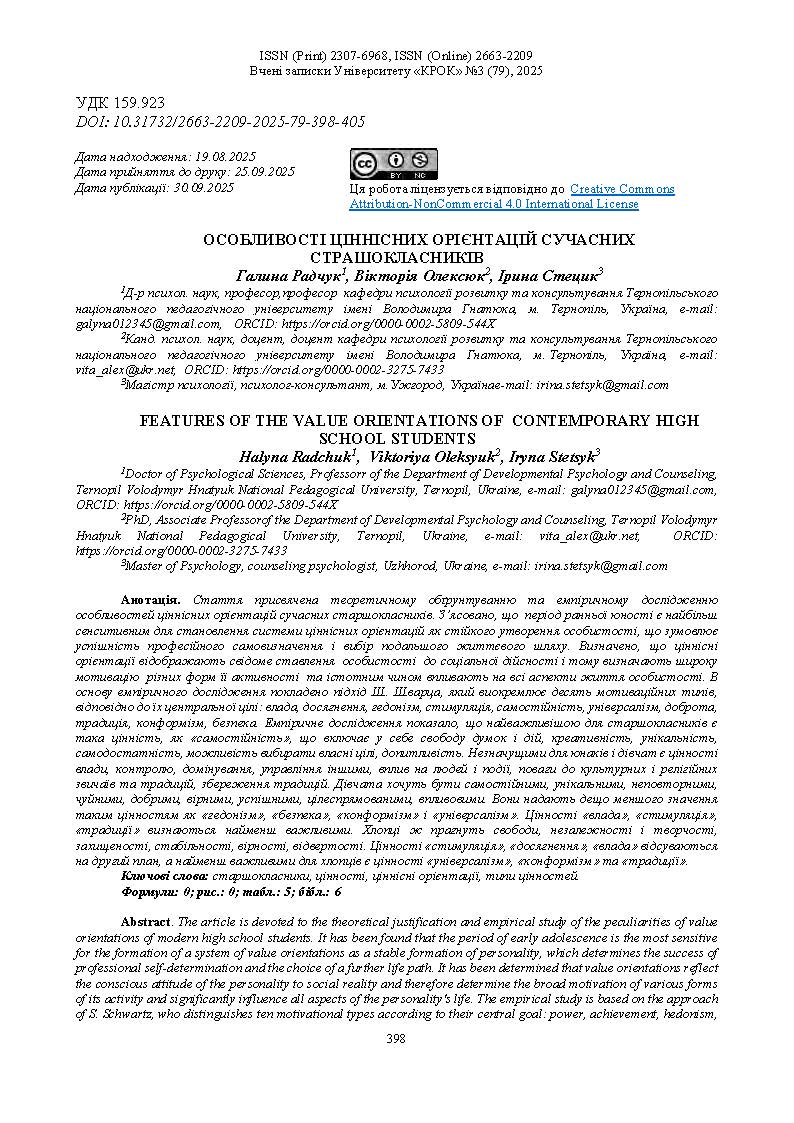FEATURES OF THE VALUE ORIENTATIONS OF CONTEMPORARY HIGH SCHOOL STUDENTS
DOI:
https://doi.org/10.31732/2663-2209-2025-79-398-405Keywords:
high school students, values, value orientations, types of valuesAbstract
The article is devoted to the theoretical justification and empirical study of the peculiarities of value orientations of modern high school students. It has been found that the period of early adolescence is the most sensitive for the formation of a system of value orientations as a stable formation of personality, which determines the success of professional self-determination and the choice of a further life path. It has been determined that value orientations reflect the conscious attitude of the personality to social reality and therefore determine the broad motivation of various forms of its activity and significantly influence all aspects of the personality's life. The empirical study is based on the approach of S. Schwartz, who distinguishes ten motivational types according to their central goal: power, achievement, hedonism, stimulation, independence, universalism, kindness, tradition, conformity, and security. Empirical research has shown that the most important value for high school students is «independence», which includes freedom of thought and action, creativity, uniqueness, self-sufficiency, the ability to choose one's own goals, and curiosity. Values such as power, control, domination, managing others, influencing people and events, respect for cultural and religious customs and traditions, and preserving traditions are insignificant for young men and women. Girls want to be independent, unique, one-of-a-kind, sensitive, kind, loyal, successful, determined, and influential. They attach slightly less importance to values such as “hedonism,” “security,” “conformism,” and “universalism.” The values of “power,” “stimulation,” and “tradition” are considered the least important. Boys, on the other hand, strive for freedom, independence, creativity, security, stability, loyalty, and openness. The values of “stimulation,” “achievement,” and ‘power’ are pushed into the background, and the least important values for boys are “universalism,” “conformity,” and “tradition.”
Downloads
References
Радчук Г. К. (2014). Аксіопсихологія вищої школи: монографія. Тернопіль: ТНПУ, 2014. 380 с.
Романюк Л.В.(2009). Цінності в структурі особистості. Проблеми сучасної психології. Збірник наукових праць К-ПНУ імені Івана Огієнка, Інституту психології ім. Г.С. Костюка АПН України,2009. № 4. С.340-353.
Сошина Ю.М. (2016). Психологічні особливості формування ціннісно-смислових настановлень у підлітковому віці. Дисерт. на здобуття наук. ступеня канд. психол. наук. Київ, 2016. 224 с. URL: https://enpuirb.udu.edu.ua/server/api/core/bitstreams/f7240c71-484f-4be7-b7ac-2197a9232390/content (дата звернення 19.07.2025).
Семків І. І. (2013). Адаптація методики Ш. Шварца «Портрет цінностей» українською мовою. Практична психологія та соціальна робота. 2013. №1. С. 12–28.
Шевчук З. М. (2012). Життєві цінності особистості як передумова розвитку духовного потенціалу в юнацькому віці. Проблеми сучасної психології. 2012. № 1. С. 83–87.
Schwartz Shalom H. (1999). Theory of Cultural Values and Some Implications for Work. Applied Psychology: An International Review. 1999. № 48. Р. 23–47.

Downloads
Published
How to Cite
Issue
Section
License

This work is licensed under a Creative Commons Attribution-NonCommercial 4.0 International License.

